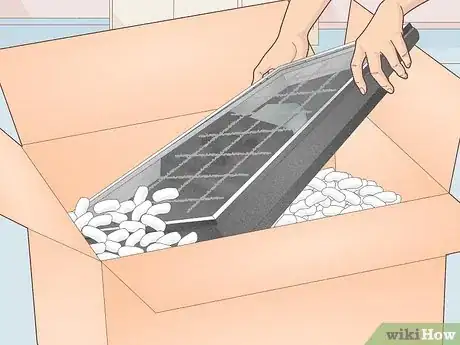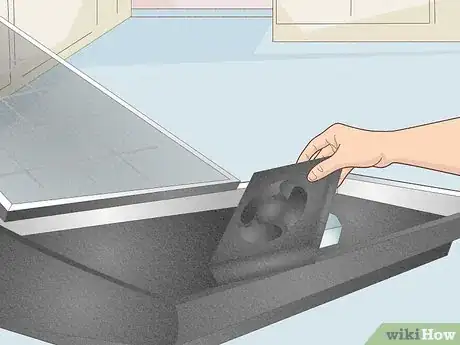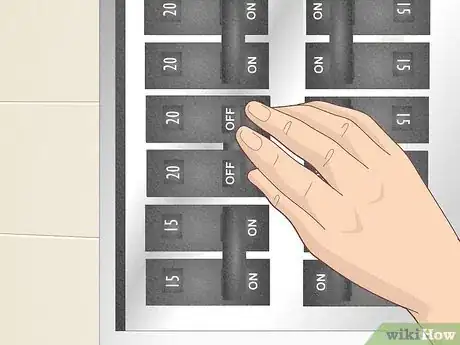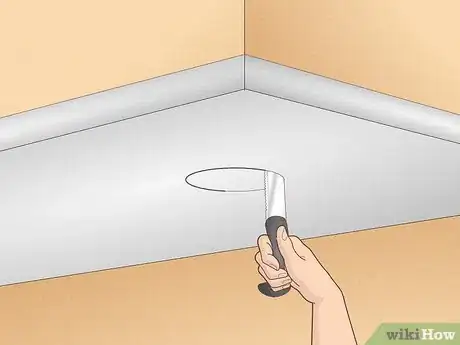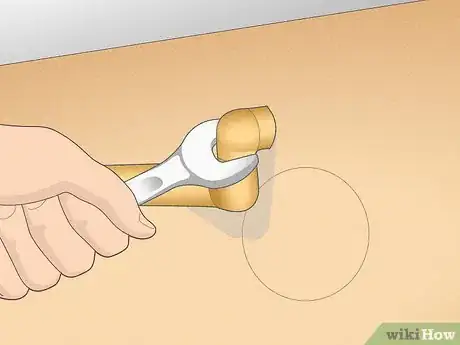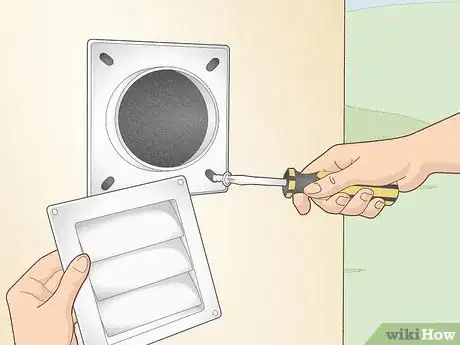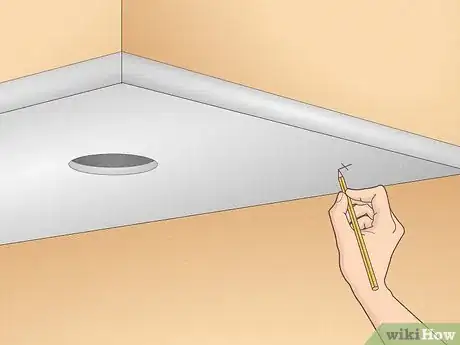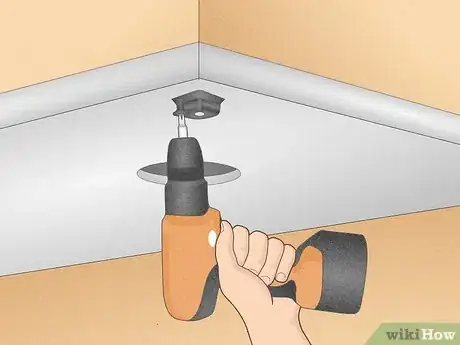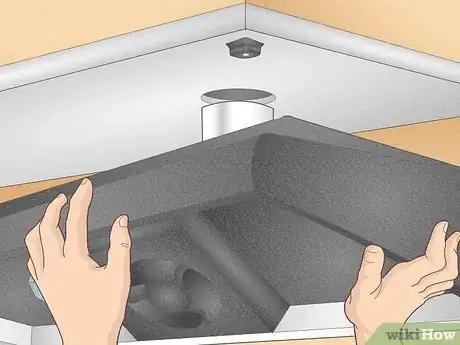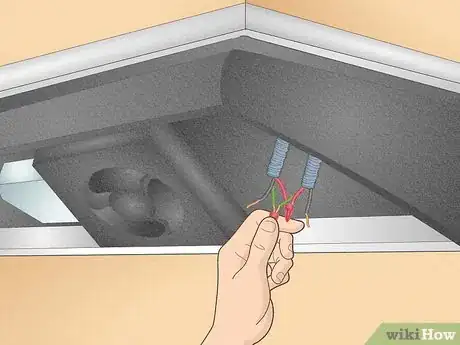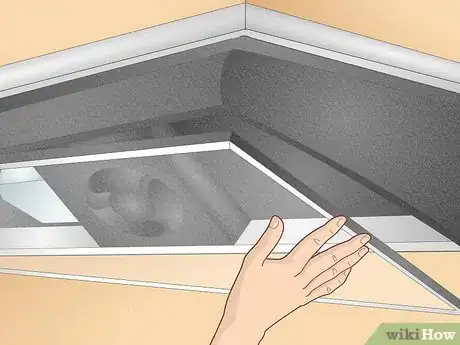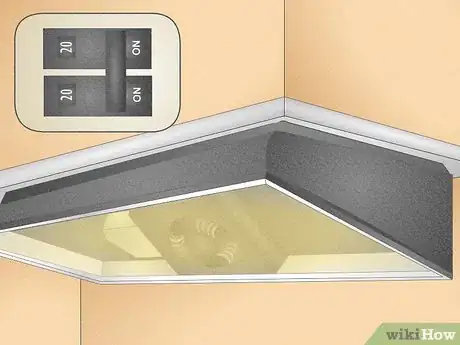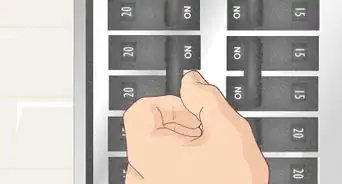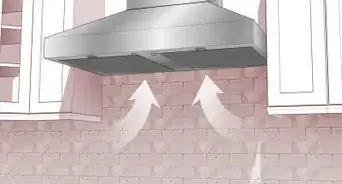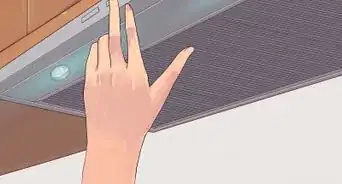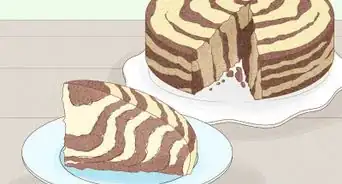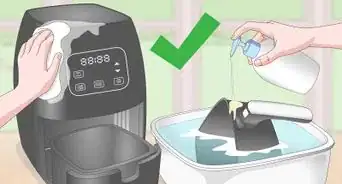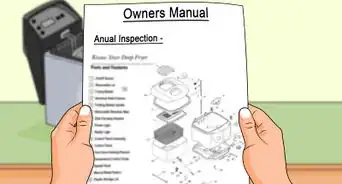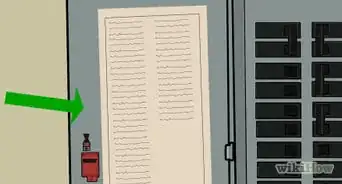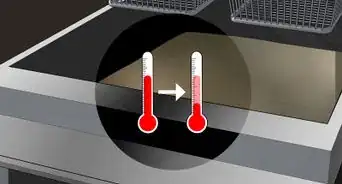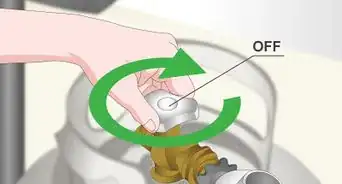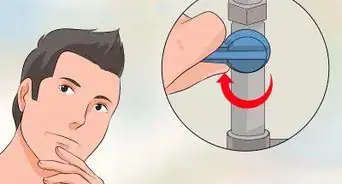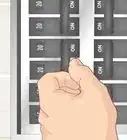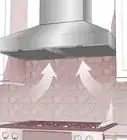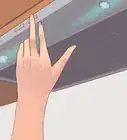wikiHow is a “wiki,” similar to Wikipedia, which means that many of our articles are co-written by multiple authors. To create this article, 11 people, some anonymous, worked to edit and improve it over time.
This article has been viewed 371,070 times.
Learn more...
Range hoods vent smoke and heat from the stove using an internal fan and filter. Range hoods are typically purchased in tandem with a stove, but they can also be bought separately. While it is normal for large appliances to be installed by professionals, it is possible to hook up your range hood without assistance with the right tools. Use these steps for installing a range hood.
Steps
Getting Ready to Install Your Range Hood
-
1Remove your old range hood, if one exists. Detach all the wires near the light fixture of the old hood by unscrewing all the wire nuts and separating the connections. Next, loosen the screws that hold the hood into place while a partner holds the old range hood in place. Lift the hood slowly off the screws, put the hood down, and remove the loosened screws.
-
2Purchase your new range hood. Make sure the range hood is large enough to cover your stovetop and that your space above the stovetop leaves at least 24 inches (60.96 cm) of clearance. If you can, purchase a range hood that extends at least one inch (2.5 cm) over all four sides of your cooking area.
- Buy a hood with the correct CFM rating. The cfm rating represents how much air the vent can pull each minute, or cubic feet per minute. To find the right cfm rating for your kitchen, multiply the square footage of your kitchen by 2. 250 cfm is a respectable amount for an average-size kitchen, while 400 cfm is excellent.
- Make sure the range hood you are buying is the correct size that will fit. The most common sizes are 36in, 48in, and 60in.
- Make sure that a venting range hood will vent through the right spot in the wall. Range hoods will vent either through the cabinets above or through the wall. If you're buying a new range hood and dealing with a pre-existing vent pipe, make sure that both connect easily. If, for example, the range supports cabinet (upper) venting but your existing vent pipe goes through the wall directly behind the vent, you're going to have trouble connecting the two.
Advertisement -
3Disassemble the cover of the range hood as well as the fan and filter underneath. Remove the filters first, then use a screwdriver to remove the bottom panels. Next, unscrew the duct connector, which is usually attached to the underside of the bottom panels in order to prevent damage during shipping. Finally, remove the perforated duct knockout from the back of the hood. Use a slotted screwdriver and a hammer for this, but be sure to work gently so that you don't damage any metal around the knockout.
-
4For safety, shut off the electricity to circuit supporting the range at the main electrical panel. Next, make sure light and power switches on the old hood are off.
- If your range hood is a plug in, just unplug it and skip this step.
Readying the Vent on Vented Hoods
If you are replacing an old vented range hood with a new one, you will not need to install ductwork or drill a rectangle for your vent. But if you are installing a venting range where none existed before, or after removing a recirculating range, you'll have to do a little extra legwork.
-
1Use the template (or instructions) that came with your hood to mark the spot in your wall or cabinet for the vent cutout. Most range hoods will come with a manufacturer's template. Use a laser level or water level to help you mark the exact middle of the wall. Then line your template up with the middle of the wall and tape it off. You're ready to start drilling for your cutout. Of course, the cutout in the wall needs to match the knockout in the range hood perfectly.
- If you need to, drill for the electrical wiring as well. If you're not familiar with electrical work, call an electrician to spec the job for you.
-
2Drill or cut for the vent. Use a drill or wallboard saw to cut through the drywall to get the templated shape of your cutout. If the space behind the wall is not occupied by any studs or piping, consider yourself lucky! If it is, there are several workarounds you can use. (See step below.)
-
3Work around any obstacles you find in your cutout. If, while cutting out the opening for the exhaust vent, you come across piping, you'll have to call an audible. Open up a larger rectangle of the wall so you can work freely. Then, you'll have to do three main things:
- Reroute and re-solder the pipe so that it leaves your opening entirely free. If you are not familiar with this type of job, it's best to call a professional plumber or general contractor to help you.
- Drill 1 x 3 cleats to the top and bottom of the wall to support the new wall patch. This will give the new wallboard that covers up the opening structural support.
- Drill, tape, and mud the new wall patch to cover up the hole entirely. Then, when it's dry, remove the original cutout for the exhaust again with your template. Follow the same procedure as before.
-
4Install any necessary ductwork so that it leads safely outside of your home. Remember that the venting cannot terminate inside the wall or attic — the exhaust must travel through duct outside of the home.
Installing the Hood
-
1Mark the holes for the screws and cable. If you have a template, now is the time to use it. Otherwise, hold the hood into place and have a partner mark inside the holes for the screws.
-
2Drill the mounting brackets or screws into the wall or cabinet above. Where you drill the screws depends largely on whether you're mounting your hood directly into the wall or into existing cabinetry. Note: If you are mounting directly into a wall using brackets, drill the screws fully into the wall; if you are mounting into existing cabinetry, drill the screws only halfway into the cabinetry — you want the range hood to be able to slip over these screws and rest on top of them.
- If you're mounting into the wall, for example, and the wall is tiled, use a nail set and hammer to tack small holes into the tile. This way, you're less likely to damage the tile when you drill your mounting brackets directly into the wall.
- If the cabinet is thin, you might need to install wooden blocks to accommodate and strengthen the mounting screws.
-
3Check your alignment. The vent should match the hole for the ductwork for vented range hoods. Realign the hood as needed before tightening the screws.
-
4Connect the wires. Run the cable from inside the wall through the cable hold in the hood. The fan and light both have black and white wires that must be attached. If you have never done an electrical project before or don't fully understand the manufacturer's electrical instructions, call an electrician to help you out.
- Connect the two black wires from inside the hood to the one black wire from inside the wall.
- Repeat this process with the white wires.
- Fasten the green grounding wire coming from the wall to a grounding screw on the range hood.
- If you are using a plug in hood, install an electric plug if you don't have an existing plug. Then plug in your hood.
-
5Reattach the filters to the hood and fasten any grease guards back onto the hood. Then, replace the hood cover by tightening the screws.
-
6Reset the power and test the workability of the fan and light.[1] If the range hood is vented, check the duct outside to ensure proper ventilation.
Community Q&A
-
QuestionHow far from the stove top should I install the range hood?
 Community AnswerThe range hood should be installed 24 to 30 inches above the stove top. Anything lower can block the use or view of large pots, and anything higher won't allow the hood to work at all.
Community AnswerThe range hood should be installed 24 to 30 inches above the stove top. Anything lower can block the use or view of large pots, and anything higher won't allow the hood to work at all. -
QuestionMy vent hood said it could be vented or ventless. It was installed vented, but I feel air being discharged from the grill on the hood. Is it possible the installer left off a part that blocks this grill in a vented installation, or is it normal for air to come out there?
 Community AnswerIt's a certainty that he didn't block off the ventless grill as instructed by the manufacturer. If the parts are gone, then aluminum tape is the only thing that can be used to seal the path to the front grill. He'll need to get tape on both sides so the tape adhesive doesn't attract and hold dust and debris.
Community AnswerIt's a certainty that he didn't block off the ventless grill as instructed by the manufacturer. If the parts are gone, then aluminum tape is the only thing that can be used to seal the path to the front grill. He'll need to get tape on both sides so the tape adhesive doesn't attract and hold dust and debris. -
QuestionCan I use PVC pipe for the air ducting?
 Community AnswerNo, it's not fire containing and will melt readily so it is not recommended to use for this.
Community AnswerNo, it's not fire containing and will melt readily so it is not recommended to use for this.
Warnings
- Do not install a range hood with electrical power running.⧼thumbs_response⧽
- When boring holes for exterior vents or for wiring, be aware of potential hazards inside the wall, including pipes, wires, and important structural elements that should not be cut.⧼thumbs_response⧽
- Always wear protective eye gear and a dust mask.⧼thumbs_response⧽
Things You'll Need
- Range hood
- Measuring tape
- Screwdriver
- Hammer
- Drill
- Mounting screws
- Wooden blocks
- Long drill bit
- Handsaw
- Goggles
- Dust mask
- Partner
About This Article
Before you install a range hood, shut off the electricity to the circuit supporting the range. Drill the holes for the screws and cable on the new hood, and attach the mounting brackets or screws into the wall or cabinet. Connect the wires to the fan and the light, then attach the filters and grease guards onto the hood and tighten the screws to replace the hood cover. Once the hood is in place, turn on the power and test the fan and the light. Keep reading to learn how to install the ductwork and drill the hole for your vent!

